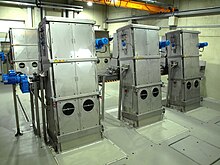Bar screen

A bar screen is a mechanical filter used to remove large objects, such as rags and plastics, from wastewater.[1] It is part of the primary filtration flow and typically is the first, or preliminary, level of filtration, being installed at the influent to a wastewater treatment plant. They typically consist of a series of vertical steel bars spaced between 1 and 3 inches apart.[2]
Bar screens come in many designs. Some employ automatic cleaning mechanisms using electric motors and chains, some must be cleaned manually by means of a heavy rake. Items removed from the influent are called screenings and are collected in dumpsters and disposed of in landfills.[1] As a bar screen collects objects, the water level will rise, and so they must be cleared regularly to prevent overflow.[3]
References
- ^ a b Streicher, Dennis. "Waste Water Treatment Plant Elmhurst, Illinois A Virtual Tour". Elmhurst College. Archived from the original on 29 March 2012. Retrieved 18 February 2012.
- ^ Spellman, Frank R. (2010). Spellman's Standard Handbook for Wastewater Operators, Volume 3. CRC Press. ISBN 978-1439818886.
- ^ Ragsdale, Fred. Wastewater System Operators Manual (PDF). Ragsdale and Associates Training Specialists, LLC. Archived from the original (PDF) on 2013-03-19. Retrieved 2012-02-18.
